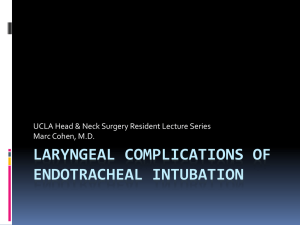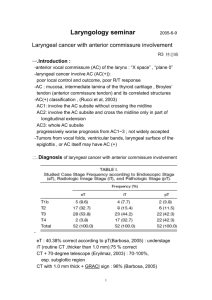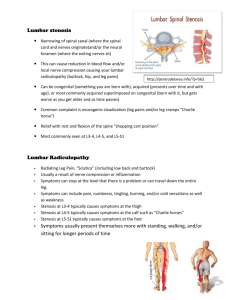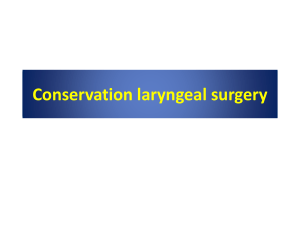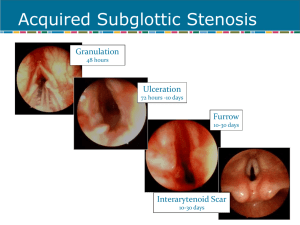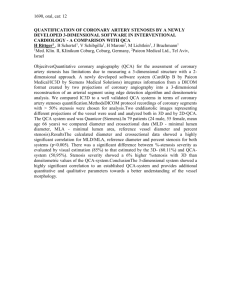Posterior glottic stenosis
advertisement
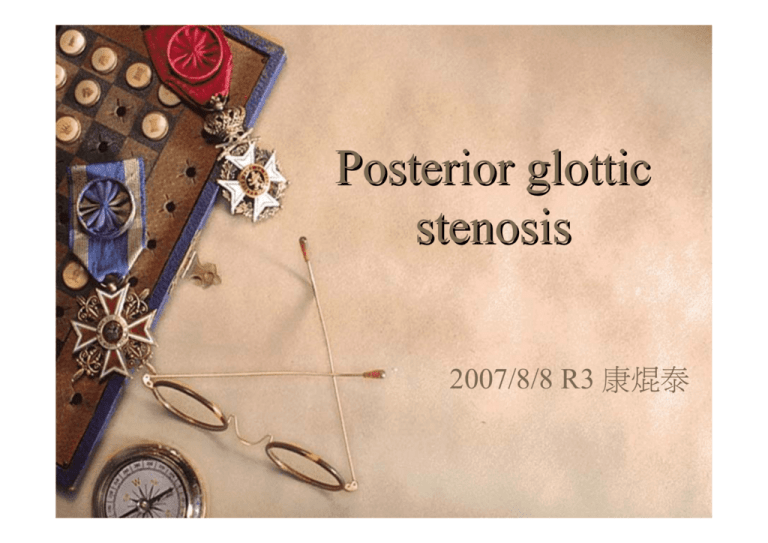
Posterior glottic stenosis 2007/8/8 R3 康焜泰 Introduction larynx : 3 distinct anatomical sites Supraglottis Glottis Subglottis Æ Subglottic stenosis is the most common form of laryngeal stenosis. Glottic stenosis may accompany subglottic stenosis or be diagnosed as a separate entity. Glottic stenosis Æ congenital or acquired Anatomy The glottic segment of the larynx : true vocal cords, the anterior and posterior commissures, and the vocal processes of the arytenoid cartilages. The posterior glottis: posterior 1/3 of the vocal cords, posterior commissure with interarytenoid muscle, the cricoid lamina, the cricoarytenoid joints, the arytenoids, and the overlying mucosa. The anterior glottis: lined with squamous epithelium, while the posterior glottis shares respiratory epithelium with the subglottis. Posterior glottic stenosis Narrowing of the airway at posterior aspect of the glottic space Most common cause: trauma from endotracheal intubation Usually scar tissueÆ impairment of mobility of one or both arytenoid cartilage Incidence: as high as 14% in patients intubate > 10 days Posterior glottic stenosis mechanism Post displacement of endotracheal tube by tongue base Post angulation of the trachea Respiratory epithelium is less likely to withstand any type of trauma Posterior glottic stenosis mechanism Glottic injury: 3 phases Acute: inflammation and ulceration of posterior commissure mucosa Chronic: granulation tissue and ulceration with exposure and destruction of arytenoid and cricoid cartilage Healing Posterior glottic stenosis mechanism Majority post glottic injury will heal after extubation with reepithelialization and no scar formation 6-14% Æ result in posterior glottic stenosis Pathogenesis is similar to subglottic stenosis Predisposing factor: duration and frequency of intubation, tube size, tube shape, systemic disease(DM…) Posterior glottic stenosis classification-1 Bogdasarian et al. 1980 classified the extent of posterior glottic stenosis into 4 types Type I interarytenoid synechia Type II posterior commissure stenosis Type III posterior commissure stenosis with one cricoarytenoid joint ankylosis Type IV posterior commissure stenosis with bilateral cricoarytenoid joint ankylosis Bogdasarian RS, Olson NR. Posterior glottic laryngeal stenosis. tolaryngol Head Neck Surg. 1980 Nov-Dec;88(6):765-72. Posterior glottic stenosi A, Interarytenoid synechia with sinus tract posterior to band. B, Posterior glottic web with mobile arytenoid cartilages. C, Fixation of one arytenoid cartilage with posterior web. D, Fixation of both arytenoid cartilage with posterior. ( From Cotton RT, Manoukian JJ: Glottic and subglottic stenosis. In Cummings CW (ed): Otolaryngology– Head & Neck Surgery. St. Louis, CV Mosby, 1986, p 2168; with permission Posterior glottic stenosis classification-2 Whited classified 2 types Type I: scarring pattern in the interarytenoid plane and inferiorly along the internal surface of cricoid lamina Type II: fibrous band between vocal processes Whited RE. Posterior commissure stenosis post long-term intubation. Laryngoscope. 1983 Oct;93(10):1314-8. Intubation Prolong or traumatic intubationÆ scarring lead to post glottic stenosis Increase risk: traumatic intubation, prolonged duration of intubation, multiple extubation and intubation, large size endotracheal tube, motion of endotracheal tube, local infection, DM, gastroesophageal reflux disease Intubation Symptoms appear late, often weeks or months after extubation Scar forms and slowly occlude the post glottisÆ impair the motion of arytenoid cartilage Systemic disease Rheumatoid arthritis , juvenile rheumatoid arthritis Æ fixation of cricoarytenoid joint Ælaryngeal stenosis SLE, gout Æ arthritis of cricoarytenoid joint Granulomatous disease tuberculosis, sarcoidosis, rhinoscleroma, or Wegener granulomatosis TB of larynx: most common, associated with pulmonary disease Most common site : inter-arytenoid space, arytenoid cartilage, post. Surface of true vocal cords, laryngeal surface of epiglottis If no treated,chrondritis and necrosis Æ destroy the larynx with scar and fibrosis Recurrent respiratory papillomatosis(RPR) Recently, post. Glottic stenosisÆ associate with treatment of recurrent respiratory papillomatosis Recurrent Respiratory papillomatosis may involve all sites of larynx, include posterior glottis Excision of these lesionÆ wound cross ant and post commissures Æ web formation Post glottic stenosis is reported in the literature after CO2 laser resection of RPR – One posterior glottic web in 22 RPR patients underwent CO2 laser resection – Prevent this complications: preserving a strip of intact mucosa, decrease power density and exposure time of CO2 laser – Ossoff RH, Werkhaven JA, Dere H. Soft-tissue complications of laser surgery for recurrent respiratory papillomatosis. Laryngoscope. 1991 Nov;101(11):1162-6 Radiation therapy Radiotherapy for laryngeal malignancy Æ induce inflammatory response Tissue recoverÆ fibrosis Æ affect cricoarytenoid joint Æ post glottic stenosis Airway obstruction: present very late (months or years) Radiation therapychondronecrosis 1-5% of patients undergoing radiotherapy may develop radiation-induced chondronecrosis. Risk factors for chondronecrosis: smoking, tumor invasion, postoperative infection, trauma, and the radiation technique. Age, sex, tumor grade, and previous laryngeal surgery do not appear to increase the risk for chondronecrosis. History and Physical examination Stridor Voice change Use of accessory muscle of respiration Retraction at supra-sternal notch Respiratory distress Exam neck(old surgical scar or mass) Cranial nerve exam Exam hands(signs of rheumatoid or osteoarthritis) Diagnostic tool Indirect laryngoscope or fiberoptic laryngoscope Æ check vocal cord mobility Direct laryngoscope or bronchoscopeÆ check larynx and distal airway, cricoarytenoid joints Diagnostic tool Pulmonary function test: helpful in documenting the severity of the obstruction, to monitor change after treatment Image study: CT or MRI Æ 1. length and thickness of glottic stenosis and subglottic stenosis 2. Useful for laryngeal framework evaluation in patients with laryngeal trauma electromyogram (EMG): differentiate posterior glottic stenosis from bilateral vocal fold paralysis. evaluate the function of the intrinsic muscles of the larynx. Diagnostic tool Lab data: for granulomatous disease(sarcoidosis, Wegener granulomatosis) or systemic disease(amyloidosis, rheumatoid arthritis) is suspected the cause Biopsy: for tuberculosis, sarcoidosis, Wegener granulomatosis Identify causative organism pH monitor: for gastroesophageal reflux Prevention Prevention of glottic stenosis appropriate airway management in terms of duration of intubation tube size sedation. avoidance of inappropriate dissection or overzealous use of the laser in endolaryngeal surgery. Treatment Treatment for post glottic stenosis classified into categories 1. Medical 2. Intralesional injections 3. Endolaryngeal procedure 4. Open surgery procedure Treatment-medical Infection or inflammatory disorderÆ appropriate antibiotics, corticosteroids, or both is important. Systemic steroids in glottic stenosis is controversial. Tend to decrease scar formation but may delay wound healing. Treatment should be individualized. Inhalational steroids are sometimes used to reduce granulation tissue formation after stent removal. Treatment-medical Steroid injection into the posterior glottic scar may be useful in cases of inflammation during the very early stages. technically difficult, and cartilage resorption may be a serious complication. Supportive therapy: humidified oxygen and close airway monitoring in a supervised setting. Treat gastroesophageal reflux Mitomycin-C Mitomycin-C: antineoplastic antibiotic alkylating agent inhibiting DNA and protein synthesis. inhibit cell division, protein synthesis, and fibroblast proliferation endoscopic CO2 laser excision Ætopical application of 0.5 cc of 0.4 mg mitomycin-C per milliliter of saline for 4 minutes at the surgical site Æ follow-up of 15 months (10-20) Result: all patients had clinical improvement of their airway and resolution of their preoperative symptoms. History Tracheotomy is the oldest surgical treatment of PGS. 1922, Chevalier Jackson: removed the entire vocal fold and ventricleÆ provided an excellent airway but caused a severe breathy dysphonia and aspiration. 1939, The King procedure is an open operation in which a mobilized arytenoid is fixed laterally. Kelly and Woodman provided further modifications of the King procedure. History 1948, Thornell described the first endoscopic arytenoidectomy 1972, Whicker and Devine reported an initial success rate of 82% in a series of 147 patients treated with Thornell's technique, which improved to 92% when some of the failures underwent a contralateral procedure. They reported a 96% voice preservation rate. History 1968, Dedo and Sooy: aryepiglottic fold mucosal flap. 1984, endoscopic use of the laser for mild posterior commissure stenosis and described the creation of a trapdoor flap. 1973, Montgomery: superiorly based advancement mucosal flap from the interarytenoid area. 1993, Zalzal described an anterior laryngofissure technique with posterior cricoidotomy and cartilage grafting. Biavati et al successfully used, in 5 children, a single-stage procedure for the repair of congenital laryngeal webs that were associated with subglottic stenosis. Recent work: endoscopic techniques for repair topical mitomycin C for prevention of restenosis. Endoscopic surgery Simplest case of post glotic stenosisÆ lysis of band with cold instrument or laser Avoid trauma to post commissure mucosa Post-operative antireflux medication: advisable Placement of simple keel, such as Silastic sheet Simple posterior glottic web with normal or mildly reduced vocal fold mobility Æ incision and dilatation with cold instrument and laser Placement of keel after lysis of post glottic webÆ increase success rate Endoscopic techniques for enlarging posterior glottic airway Æ excision of tissue at or anterior to arytenoid 1983, Ossoff classic CO2 laser arytenoidectomy and partial cordectomy Vaporization of mucosa overlying arytenoid cartilage, the cartilage itself, portion of posterior aspect of membranous vocal fold 1991, Ossoff report 86% rate of decannulation in a series of 28 patients Modified Ossoff’s technique: preserving the mucosa along the medial aspect of the arytenoid cartilage Preserved medial mucosaÆ endoscopically sutured laterally after resection of arytenoid cartilage Others: resect varying portion of arytenoid cartilage, preserve the mucosa and suture it laterally 2000, Goldberg: endoscopic postcricoid advancement flap (EPAF) Place vascularized mucosal flap between arytenoid to prevent restenosis Candidates for EPAF: type II or type III stenosis, with at least one mobile cricoarytenoid joint Fig. 1. View of a larynx with posterior glottic stenosis by direct laryngoscopy. Note interarytenoid scarring and a narrowed airway. Fig. 2. Diagram of elevation of the inferiorly based postcricoid flap. Here, the flap is reflected posteriorly. Incision for arytenoid separation is shown with dashed lines. Fig. 3. Endoscopic view of the larynx with the incision for arytenoid separation. The incision is being held open by two probes for demonstration purposes. Fig. 4. Diagram of the inset of the mucosal flap into the gap created by the arytenoid separation. Fig. 5. Endoscopic view of the larynx from 1week after surgery, demonstrating improved airway, improved arytenoid abduction, and recreation of the interarytenoid space. The flap is visible between the arytenoids Open surgery Post glottis may be approach through anterior laryngofissure Anterior thyroid cartilage must be divided exactly in the midline at anterior commissure to avoid ant vocal fold injury Lysis post glottic scar tissue Æ flap or graft or stents 1973, Montgomery: midline ant laryngoffissureÆ post web excised Æ mucosal flap is elevated from interarytenoid space and post cricoid region 1988 Goodwin et al: graft the exposed area with either skin, mucosal, perichondrocutaneous grafts Stenting is used for 1-6 weeks Conclusion Post glottic stenosis: most common cause: trauma from endotracheal intubation Treatment based on patient’s condition, presentation Reference 1.Bogdasarian RS, Olson NR: Posterior glottic laryngeal stenosis. Otolaryngol Head Neck Surg 88:765–772, 1980 2. Crockett DM, McCabe BF, Shive CJ: Complications of laser surgery for recurrent respiratory papillomatosis. Ann Otol Rhinol Laryngol 96:639–644, 1987 3. Dedo HH, Sooy CD: Endoscopic laser repair of posterior glottic, subglottic and tracheal stenosis by division or micro-trapdoor flap. Laryngoscope 94:445–450, 1984 4. Eckel HE, Thumfart M, Wasserman K, et al: Cordectomy versus arytenoidectomy in the management of bilateral vocal cord paralysis. Ann Otol Rhinol Laryngol 103:852–857, 1994 5. Goldberg AN: Endoscopic postcricoid advancement flap for posterior glottic stenosis. Laryngoscope 110:482–485, 2000 6. Hoasjoe DK, Scott FW, Aarstad RF, et al: Posterior glottic stenosis mechanism and surgical management. Laryngoscope 107:675–679, 1997 7. Irving RM, Bailey CM, Evans JNG: Posterior glottic stenosis in children. Int J Pediatr Otorhinolaryngol 28:11–23, 1993 8. Langman AW, Lee KC, Dedo HH: The endoscopic teflon keel for posterior and total glottic stenosis. Laryngoscope 99:571–577, 1989 9.Montgomery WW: Posterior and complete laryngeal (glottic) stenosis. Arch Otolaryngol Head Neck Surg 98:170–175, 1973 10. Rimell FL, Dohar JE: Endoscopic management of pediatric posterior glottic stenosis. Ann Otol Rhinol Laryngol 107:285–290, 1998

